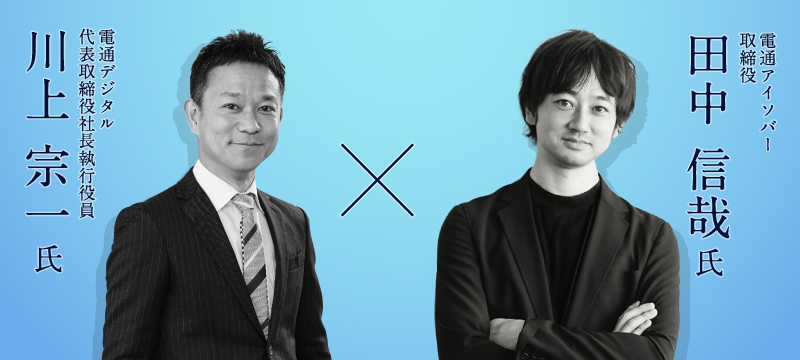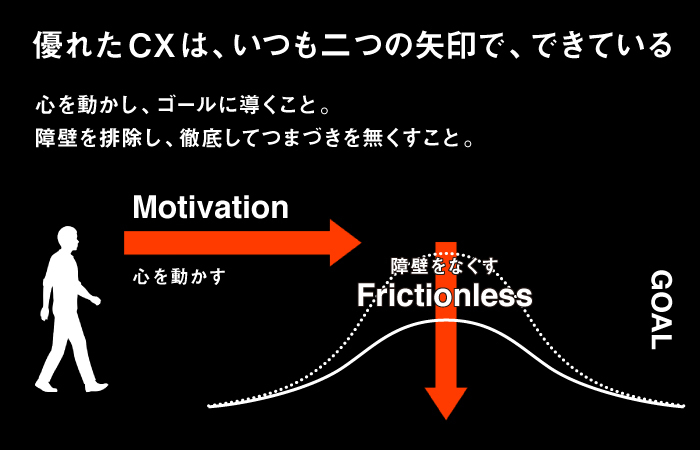The world's largest marketing and communications event, "Advertising Week 2020: Asia," was held online on October 14 and 15. On the day, leaders from around the world gathered under a wide range of themes including marketing, media, technology, and brands, with various sessions taking place.
In one session, "Rethinking How to Move Hearts," representatives from Dentsu Digital Inc. and Dentsu Isobar—responsible for CX (Customer Experience) and DX (Digital Transformation) design within the Dentsu Group—took the stage. They discussed creativity and the consumer perspective that must not be left behind, even in this accelerating era.

Brands are built on "Motivation" and "Frictionless"
At the session's outset, Dentsu Inc. Isobar's Shinya Tanaka introduced the company's proposed model for building exceptional CX. "Exceptional CX is remarkably simple and can be explained by these two arrows: Motivation and Frictionless. Both must exist, and it's crucial that both function effectively," he stated.
- Motivation: The arrow that moves consumers' hearts, guiding them toward goals like "getting them to buy" or "getting them to like it." This is where advertising, promotion, and branding excel.
- Frictionless: The arrow that removes barriers, making it easier for consumers to reach their goals. This is the domain of digital marketing and platforms.
Mr. Soichi Kawakami of Dentsu Digital Inc. agreed with this CX construction model. He emphasized the importance of designing CX from the consumer's perspective, keeping both arrows in mind.
"Simply put, CX design means thinking about what services or products you would want to use if you were in the consumer's shoes. You won't pay attention unless you think 'This service looks interesting,' and even if you think it looks interesting, you won't use it if it's extremely difficult to use. So, the idea of designing CX using these two arrows is very clear.
Another strength of this CX model is that motivation and frictionless experience aren't isolated points but form a continuous line. Previously, it was common for projects to end once a commercial was delivered or a sale was made.
But now, with smartphones, we live in an era where we're constantly connected to various media and companies. Consumers want to experience something interesting every day. Therefore, it's crucial to operate 'Always on', continuously engaging consumers' hearts while making their lives more comfortable. I feel these two arrows embody the meaning of thinking about consumers daily and pursuing 'how to make them enjoy it' and 'how to make it comfortable for them to use'." (Mr. Kawakami)
Both further emphasized the importance of these two arrows contributing to the brand. Tanaka stated, "Brands that are loved long-term have motivation and frictionless experiences unconsciously integrated into consumers' lives."
Regarding how much frictionless experience can contribute to a brand, Mr. Kawakami explained, "Frictionless alone doesn't create the initial motivation like 'I want it' or 'I want to try it.' For motivation, the product or service itself must be appealing. However, when looking at the dynamics of 'continuing to use it' as a continuous line, improving products and services from the user's perspective to eliminate minor stumbling blocks during use becomes crucial for brand building."
On the other hand, Tanaka stated that for motivation to contribute to the brand, creativity remains vital. In the frictionless aspect, it is ideal for this creativity to be expressed not in the end product itself, but rather in the "methods and perspectives" employed.
Cultivating a brand that is loved for the long term. That means "creating a sense of seasonality within the heart."
Next, both speakers discussed what is needed to cultivate a brand that is loved for the long term, drawing on examples from their past work.
Kawakami, who has long been involved in branding for major clients, particularly in the entertainment sector, cited the example of record companies branding music artists.
"Record companies constantly consider their target audience and devise various strategies to ensure artists can sustain their music careers long-term. They carefully consider the musical style—like releasing an up-tempo song after a ballad—and plan music videos, CD jackets, and live performances based on the target audience's preferences. They manage and produce everything chronologically. After releasing a new song, they meticulously plan how to build excitement until the next release, breaking it down into small cycles and consciously focusing on 'creating a season' every month." (Kawakami)
Mr. Tanaka worked with domestic luxury car brands and cosmetics brands. For both, he emphasized the importance of maintaining the brand's freshness.
"Cosmetics often feature seasonal products, and luxury cars undergo model changes every few years, making brand freshness vulnerable to decline. Therefore, what I prioritized was 'maintaining that freshness continuously.' For example, with luxury cars, if you stick to the old-fashioned image of 'escortering a woman in a dress to the car,' the brand ages rapidly. To prevent that, I focused on creating a worldview younger than the typical buyer demographic, weaving in artistry and playfulness to constantly provide new stimulation." (Tanaka)
Both executives focused on ensuring products and services "remain fresh in consumers' minds." Kawakami stated, "The most crucial thing is directly connecting with today's consumers. It's about positioning the brand where people feel 'I want to be moved' or 'I want to use this now.' Even great music won't sell if it doesn't move people today."
Tanaka added, "A luxury car is a major purchase; people don't see a commercial and immediately think, 'I'll buy it right now.' However, if the commercial for the car they bought is clichéd, it diminishes the appreciation they feel after paying the price. We aimed for branding that allowed people to feel the brand's worldview both before and after becoming owners, maintaining a high level of satisfaction in owning that car."
To eliminate barriers between departments and realize the two arrows
Furthermore, Tanaka questioned why, while the term "digital marketing" is commonly heard, "digital branding" is less frequently discussed in relation to "moving hearts now."
In response, Mr. Kawakami shared his unique perspective: "In the digital marketing world, the awareness stage at the top of the funnel is sometimes called the 'branding domain.' However, branding isn't just about awareness; it's essential beyond that stage too. The goal of branding is for products and services to become beloved by consumers, to remain comfortable and usable for 10, 20 years... and beyond. To achieve this, any method is acceptable. Essentially, a brand is built by accumulating experiences that make customers feel 'liked, comfortable, and wanting to keep using it' at every touchpoint."
Simultaneously, Mr. Kawakami pointed out, "Many companies face problems when conducting branding."
"What I perceive as problematic in corporate branding is the lack of alignment between departments. Even for the same product, we often see cases where different departments—like advertising, creative, or CRM-focused marketing—are trying to nurture the brand from different angles. To solve this, Dentsu Digital Inc. stations our employees at client companies. We connect departments and support everyone in thinking about branding with a shared direction," said Kawakami.
Mr. Tanaka also addresses this issue, stating, "Without breaking down departmental boundaries, you cannot achieve good CX or good branding."
"When realizing the arrows of motivation and frictionless, as explained at the beginning, we arrive at the same challenge. The motivation arrow is often handled by the advertising department, while the frictionless aspect is typically managed by digital marketing or systems departments. Furthermore, there's the problem of differing KPIs and organizational cultures within each department. I believe success hinges on whether we can eliminate barriers between departments and build both arrows while sharing a common direction. In that sense, we must return to basics and reaffirm that a brand is shaped by the company's overall behavior." (Mr. Tanaka)
Looking Ahead: "Moving Beyond Homogeneity" and "Creating Serendipity"
The session concluded by exploring "perspectives we should value going forward to move hearts," considering various issues triggered by digitalization.
Mr. Kawakami pointed out, "While digital marketing has evolved, making it easier to devise measures that move hearts, this has led to an 'optimization paradox.'"
"Digital excels at eliminating waste to reach a single optimal solution. However, when every company pursues this one optimal answer, homogenization advances, and consumers perceive everything as indistinguishable. We call this phenomenon, where products and services become homogenized and unsellable despite achieving the optimal solution, the 'Optimization Paradox'," explained Mr. Kawakami.
Meanwhile, Tanaka addressed the "loss of serendipity" caused by optimization. "Human lives are enriched by chance encounters. Yet as digital marketing optimization advances, people encounter only personalized information. In other words, optimization may be robbing consumers of opportunities for serendipitous encounters," he expressed concern.
Pursuing optimization is essential for efficiently advancing business activities. However, to better move consumers' hearts, marketers must return to the perspective of the individual consumer and consider purely what is enjoyable and comfortable for them, rather than what is convenient for the sender. To continue creating moments of relevance within consumers' hearts, he suggested that "de-homogenization" and "creating serendipity" will become important themes going forward, concluding the session.





